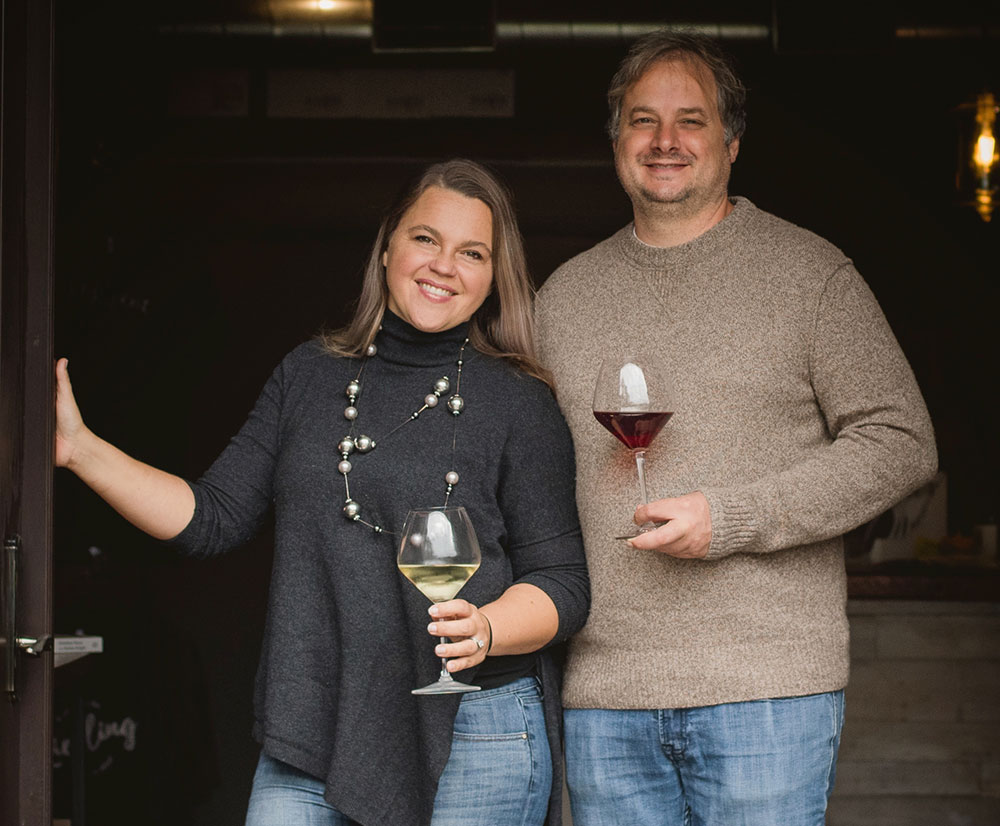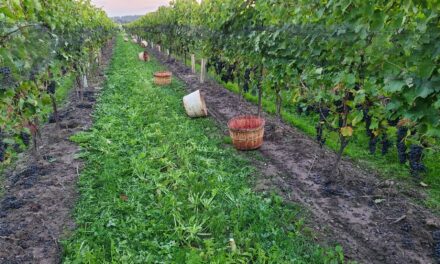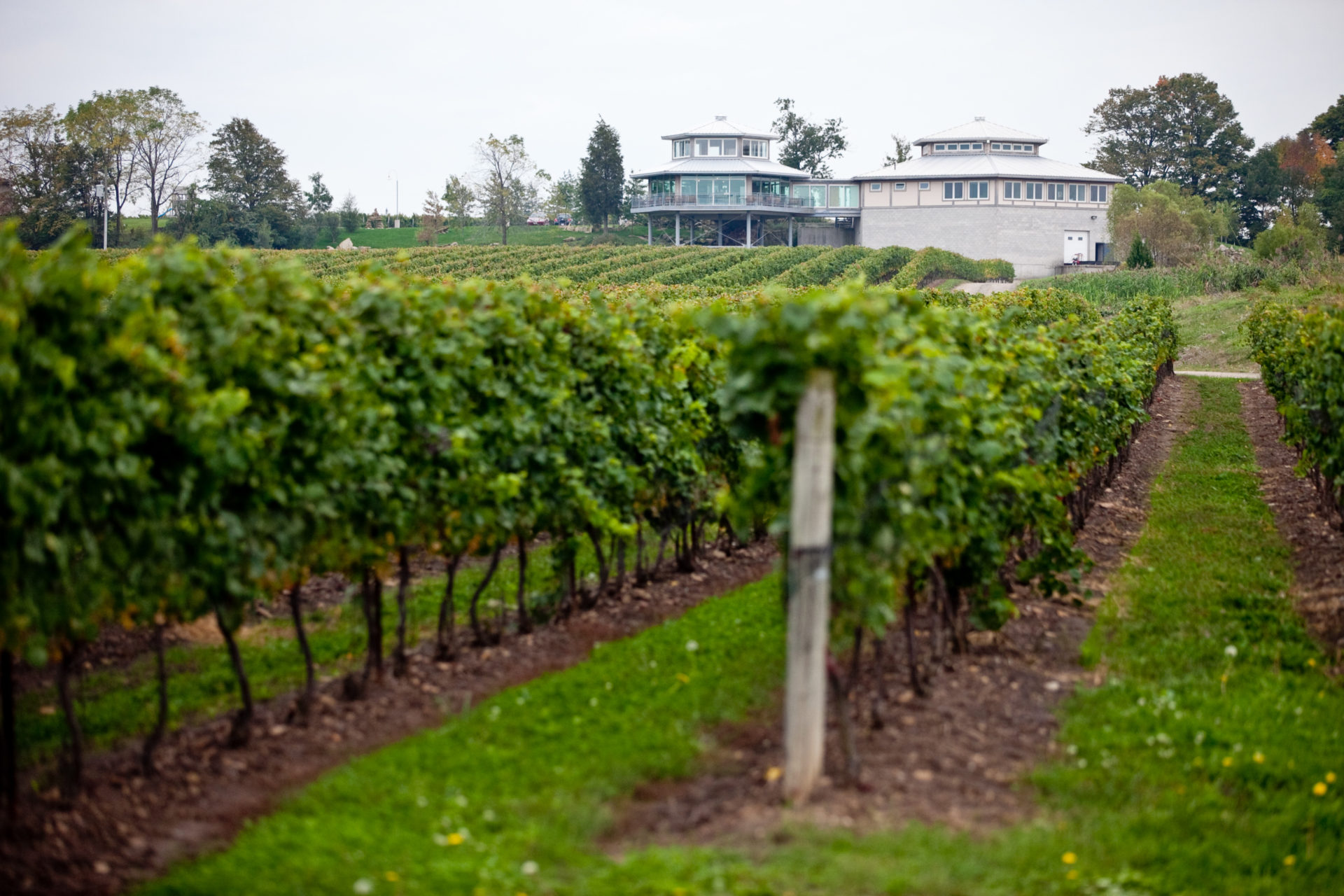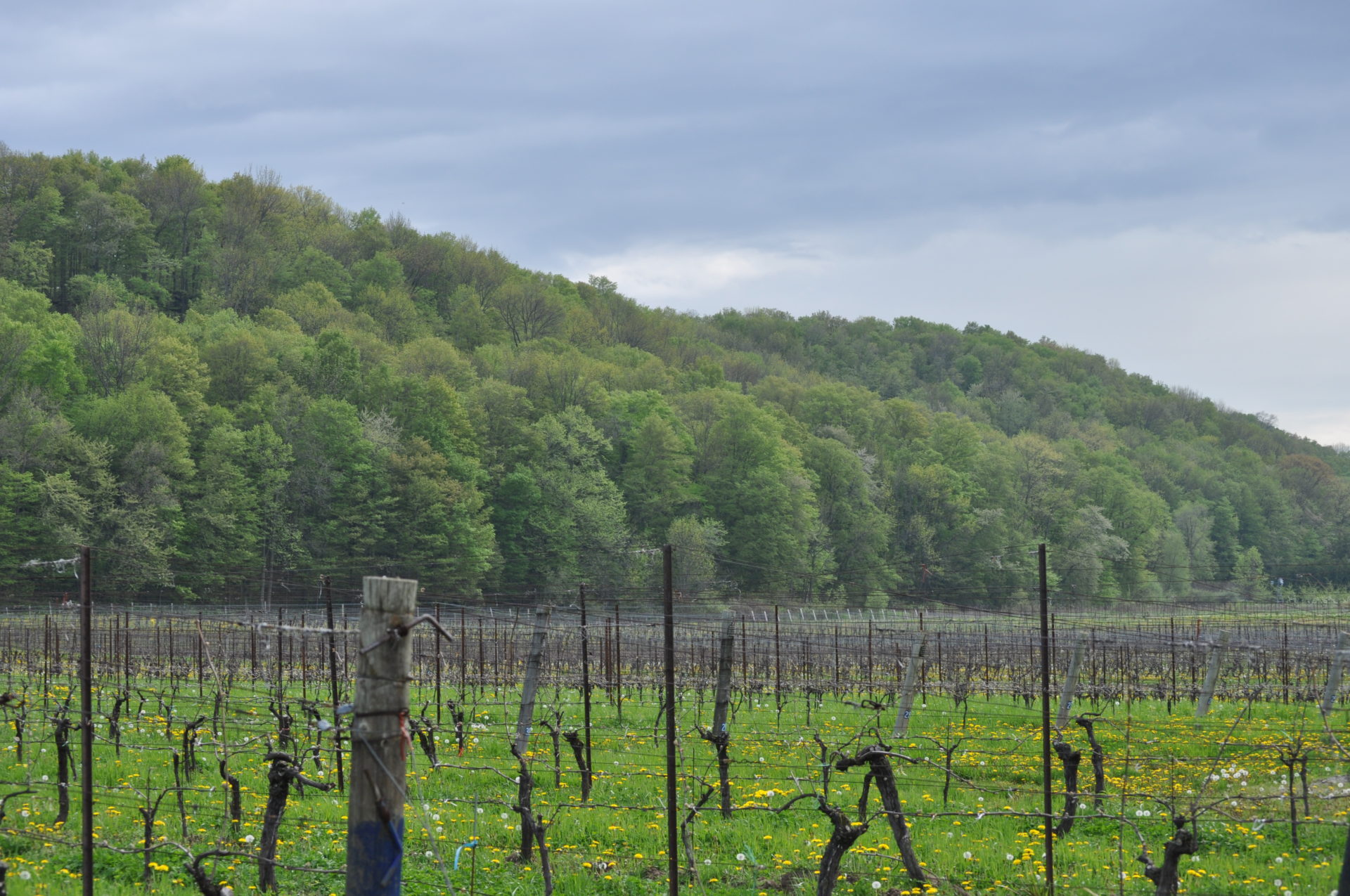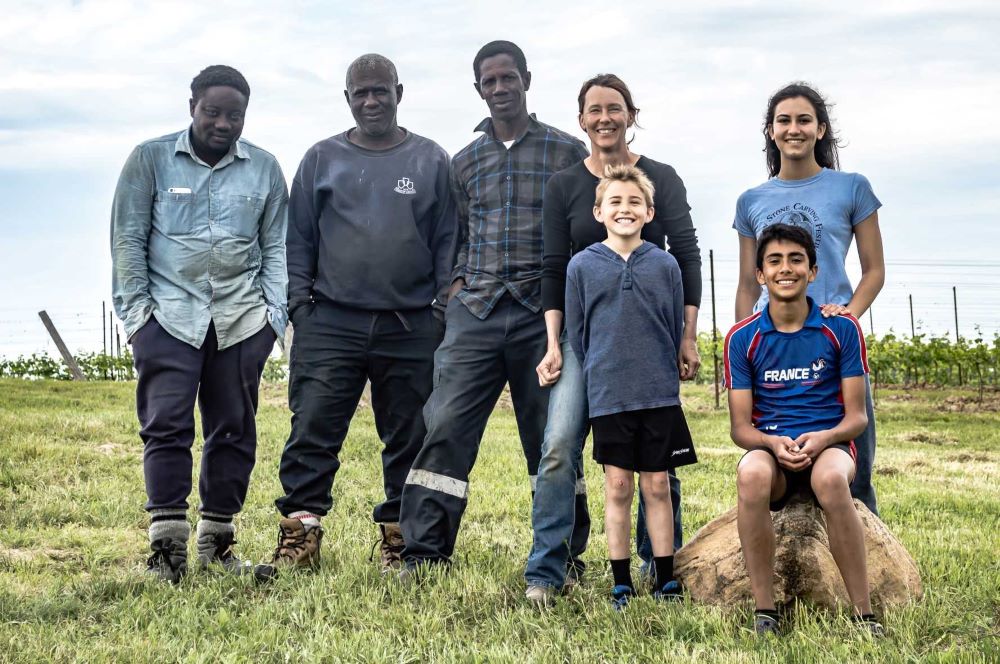
Nadia and Ilya Senchuk of Leaning Post Wines
I have always viewed a winemaker’s passion around single-vineyard expressions in a glass as a hyper sensitive kin to artistry. My time with Nadia Senchuk, co-founder of Leaning Post Wines, confirmed this.
Leaning Post Wines is owned by Nadia and Ilya Senchuk. The winery (farm) is in a compelling location nestled back from the main road, making it that if it is your first time there and you’re driving a tad too fast, you may miss it. The farmhouse sits in front of the Senchuk Vineyard and houses the wineries tasting room, bottle shop and winemaking facilities. It is a quaint and cozy reminder of history and place, not unlike what Nadia and Ilya have produced in the bottle, with their single-vineyard expressions.
While the early stages of sourcing Niagara Peninsula grapes for Leaning Post Wines were out of a need to support winemaking at their virtual winery, the relationships forged with local grape growers and the stories behind each parcel of land divulged distinction, plot by plot. It became evident that there were noted differences in the wine, as you travelled, by way of the wine in your glass, sub-appellation to sub-appellation. And from there, the Leaning Post endless quest and discovery for new plots of land and single-vineyard wines was born.
The single-vineyard instinct and insight came out while tasting with Nadia. We were doing the Pinot Noirs’; Lowery (St. David’s Bench), Senchuk (Lincoln Lakeshore), and Grimsby Hillside (Lincoln Lakeshore), and she had me pay special attention to the two wines from the Lincoln Lakeshore sub-appellation. Though a part of the same geographical designation, there were clear and noted differences in the Senchuk and Grimsby Hillside wines. After confirming that the winemaking for both was virtually the same, you could not help but see the impact of ‘place’. “We’re finding a time and place and putting it in the bottle,” Nadia said as I commented on how lovely but yet different both wines were.
With Grimsby Hillside being a cooler site affording greater hang time for grapes, and with its elevated aspect ratio, you get two wines with differing levels of austerity, structure, red fruit condition, and spice. Nadia took the exercise one step further while tasting the Chardonnay single vineyard wines and the Pinot Noir. After we tasted the wines and I lamented on quality and likened some to a Burgundian expression, she had me play winemaker and try mixing the wines in my glass together. After a slight pause at the pending disaster I would bring to works of art in front me, I complied. The Chardonnay’s became one drink of relatively lifeless wine; just an ‘ok’ Chardonnay, and the Pinot Noirs, as one, lost much of that spicy character, noted minerality, and bright red fruit structure that plays a large part in the wines complexity. It was her rudimental way of showing me how wonderfully these wines show as single-vineyard expressions and what can be lost if we choose to produce them as a mashup. “Think of it as art. If you put too much on the canvas, your eye does not know where to look,” said Nadia.
My rudimental winemaking experience with Nadia got me thinking and asking about consumer education. We talked about how, with education on sub-appellation diversity, Ontario consumers can start to see the value and meaning behind the single-vineyard wines produced. When asked how she would describe the importance of single-vineyard wines to consumers, Nadia replied, “I would talk about that specific place and talk about the people behind it as well. It’s not just about the winemaker. There is a beautiful marriage with vineyard and winemaker. I would talk about the family behind the grapes. The independent growers really should get credit for what they are doing too. Their personal stories are a big component”.
A View Into the Wines
Nadia and I tasted through three single-vineyard whites, all Chardonnay, and three reds, all Pinot Noir. The amusing stories and anecdotes shared while tasting were not lost on me either!
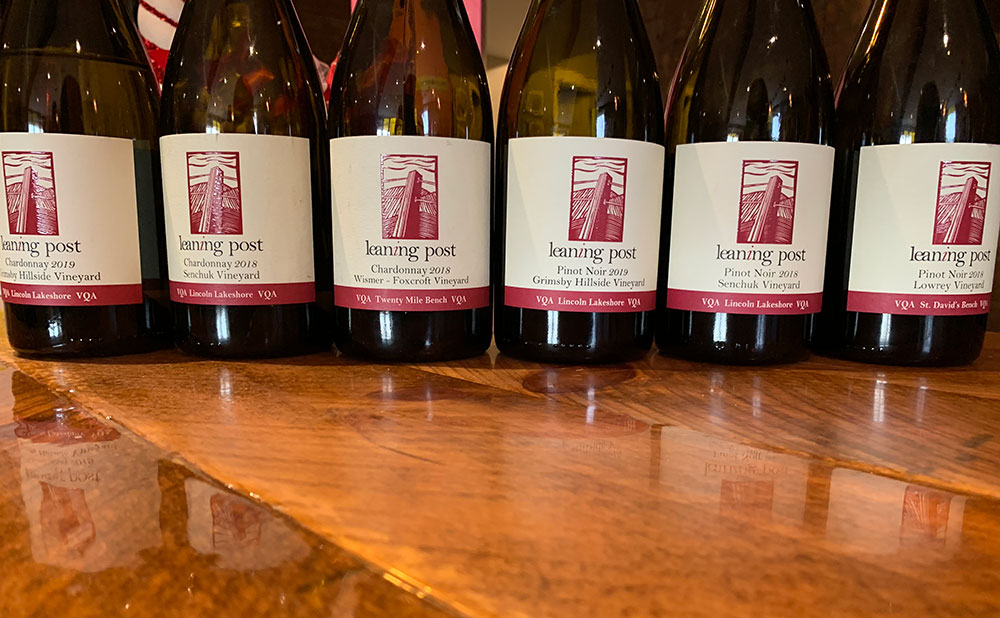
Leaning Post Wines single vineyard Chardonnay and Pinot Noir
Chardonnay – Wismer Foxcroft Vineyard – Twenty Mile Bench
Apple, pear, lemon, lime, almond, and tepid oak on the nose, followed by lemon curd, apple blossom, and distinct minerality on the palate. It brings white Burgundy to mind! Though wonderful to drink now, this Chardonnay can age.
Soil composition: clay loam soil, with varying degrees of silt and limestone gravel and boulders.
![]()
Chardonnay – Senchuk Vineyard – Lincoln Lakeshore
Wonderful scents of jasmine, grilled pineapple, green apple, and stoney minerality. The palate brings you zippy citrus notes and spice that take you to a tropical place, a distinction of the Senchuk Chardonnay. As Nadia puts it, “it takes you to the beach”.
Soil composition: stoney silty soil with a limestone clay base.
![]()
Chardonnay – Grimsby Hillside Vineyard – Lincoln Lakeshore
White flowers jump out at first, followed by brilliant citrus notes, green apple, and flint.
The palate provides an astonishing balance of citrus peel, peach, pear, celery leaf, and rounding minerality. The shape of the non-fruit characters in this wine made it distinct from the other Chardonnay’s we tried that day.
The Grimsby Hillside Chardonnay is a wildly delicious and complex white that is a must-try.
Soil composition: red clay loam.
![]()
Pinot Noir – Lowrey Vineyard – St. David’s Bench
Red berries, roses, cured meat, and tobacco on the nose, followed by bright red fruit, currant, and crushed tomato leaf on the palate with firm but silky tannins.
Fun fact, Ilya and Nadia started making Pinot Noir from the Lowrey Vineyard in 2009, and their experience with this plot of land is apparent in the glass!
Soil composition: clay, loam, and limestone.
![]()
Pinot Noir – Senchuk Vineyard – Lincoln Lakeshore
Stunning cherry, pomegranate, baking spices, and mushrooms come alive on the nose. The palate then brings you austere tannins with earthy notes at the front and red fruit in tow.
The Senchuk Vineyard Pinot Noir is a wonderful age-worthy red and distinctly takes you to Burgundy!
Soil composition: stoney silty soil with a limestone clay base.
![]()
Pinot Noir – Grimsby Hillside Vineyard – Lincoln Lakeshore
Deep ruby, with smells of red cherry, black currant, clove, captivating floral notes, and white pepper. On the palate, cherry, pomegranate, raspberry, anise, bay leaf, indefectible acidity, and silken tannins sing. Though this wine comes in at 14% alcohol, you would never notice. Balance, balance, balance!
A red fruit and spice beauty with daring levels of complexity. It is delicious now but will continue to give for years.
This is Leaning Post’s first vintage of the Grimsby Hillside Pinot Noir and a must-try.
Soil composition: red clay loam.
![]()
(All wines are rated out of a possible five apples)
There was no denying a sense of place in each glass lined up for our tasting. “We want to showcase and find these awesome small plots of land,” Nadia said, also adding that “it is important to differentiate Ontario wines by showing locally sourced ingredients [grapes]”.
Nadia and Ilya are well vested in not only their vineyard and winemaking projects but the Ontario winemaking industry as a whole. Nadia is now a member of the VQA board, and Ilya sits on the Ontario Craft Wineries board. Both organizations play a crucial role in not only consumer communications but also Ontario wine standards. With individuals such as Nadia and Ilya contributing to industry organizations such as these, it is testimony that the study of land and sub-appellations is not done. Will we eventually see the concept of Grand Cru clearly defined and designated here in Ontario? Will we see that Grimsby Narrows sub-appellation that elite winemakers talk about finally come to fruition? While the answers to the previous questions are yet unknown, I believe the Ontario wine industry’s curious exploration of terroir is an exciting and intriguing effectuation.
In closing, it was also great to meet someone who adoringly refers to Sauvignon Blanc as Sauvi B, just as I do!

